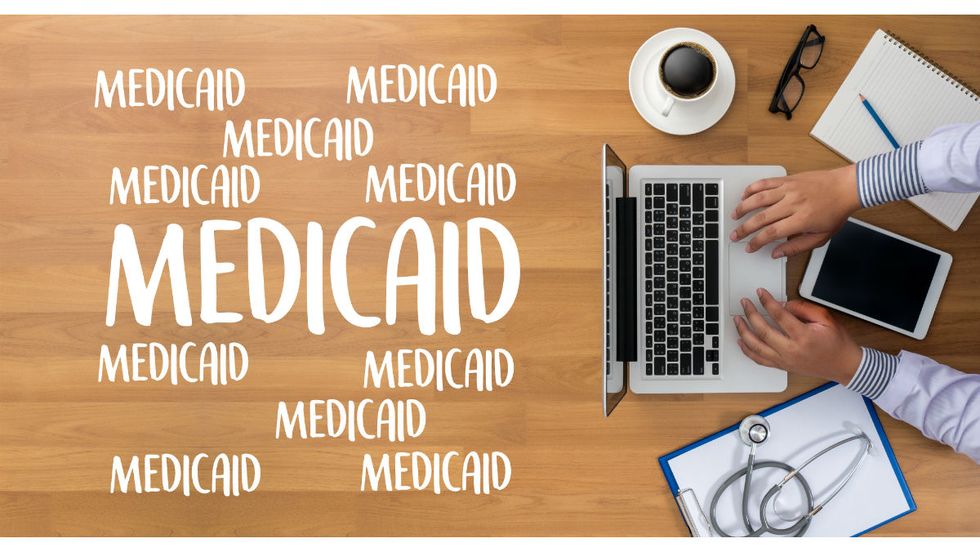
© 2025 Blaze Media LLC. All rights reserved.
Medicaid reform: Just cut out the broken program and give them the money
The entire health insurance market was destroyed by Obamacare, all for the purpose of achieving higher “coverage” numbers, of which 84 percent was the result of the Medicaid expansion.
Instead of destroying our health care because of Medicaid, what if I were to tell you we could end the entire crony, market-distorting program, hand poor individuals HSA accounts filled with the same amount of money to shop for their needs like anyone else, and provide them with better quality, more choices, and less stigma – all without self-perpetuating a death spiral of eye-popping debt and price increases that destroy the market for everyone else?
Sounds like a tall order, right? Well, if we cut out the bureaucracy and the hospital-insurance cartel, it would be as easy as setting up a regulated HSA or IRA, except that the taxpayers would supply the money.
Cutting out the greedy middle man, endless inflation of health care, and promoting direct care
Last week, I sketched a vision for true market reform for the non-indigent and healthy populations in health care itself by cutting out the middle man of the insurance cartel. It would involve health sharing associations for catastrophic coverage (or insurance, if the existing companies are willing to innovate and offer such plans) and paying the rest out of pocket through transparent and competitive pricing.
In other words, it would work like any other market, which as we’ve seen in this era of the internet and modern technology, would spawn a revolution in the quality of delivery and the reduction in prices. Everyone would be paying a fraction of the price, because the charges would actually match the true cost of health products and services — plus, the hundreds of billions in administrative costs of the insurance and government cartel would be history.
By bringing down the cost of health care (not just insurance) for those not on public programs, it will make true reform of Medicaid and dealing with the chronically ill levels easier and cheaper without sacrificing the safety net. We could directly subsidize the needy without destroying health care the same way we do with food stamps without destroying the food market. Yes — as a conservative, I’m telling you that if we merely ran Medicaid like food stamps and directly empowered the consumer to purchase the product, we would solve health care in America.
The fact that 75 million people are on Medicaid is appalling. As late as 1990, nearly 25 years into the program, there were just 22.9 million enrolled at a cost of $41 billion. As late as the end of the Clinton presidency, there were 34.5 million enrolled at a cost of $117 billion. Now, between Medicaid and CHIP, there are 74.5 million people enrolled at a cost of $410 billion, plus an additional $150 billion spent by the states.
However, in the spirit of bipartisanship, we can agree to keep the entire Medicaid expansion and cover the same number of people if we actually reformed the program to grant direct access to care rather than destroy the market with an inefficacious crony insurance program.
The key is to ensure that the program doesn’t skyrocket to $1 trillion, as it is projected to reach by 2026. Federal spending on health care (not including state expenditures) is projected to be $16.5 trillion over the next 10 years, dwarfing the cost of Social Security and the military. By 2047, health care spending will be about 25 percent greater than the insolvent and crushing cost of Social Security. Thus, if we could merely freeze spending now, we’d save ourselves a lot of trouble down the road.
The best way to give a handout is to give a direct handout
Now, let’s go through the basic enrollment numbers and cost of Medicaid. Using 2015 numbers (enrollment has only gone up), the combined federal and state scope and cost of the Medicaid program breaks down as follows.
Enrollment: 70 million individuals
-Cost: $554 billion
-Benefit payments:$527 billion
-Administrative costs: $26 billion
Average cost per enrollee: $7,492
-Aged: $14,323
-Disabled: $19,478
-Children: $3,389
-Adults: $4,986
If we simply cut out the hospital and insurance cartels and handed people roughly the same average payout to purchase their own risk pooling care and out-of-pocket shopping for care, and the rest of the non-subsidized population moved to such a system (Phase 1 of this plan), prices would have already come down so dramatically that we wouldn’t need to spend nearly this much money.
But let’s work, for now, under the assumption that we are not fixing the health care market in general. Here’s how the math breaks down.
Say a low-income married couple with two children that are not disabled or particularly ill would receive an annual HSA payment from the remodeled program similar to the current average benefit paid out to such a family. Two adults ($4,986 apiece) plus two children ($3,389 apiece) would get $16,750 in subsidized funding into their escrow account.
Right away you can easily see why they wouldn’t need nearly as much of a subsidy under a system of direct primary care and health sharing associations (or catastrophic insurance, if we actually repealed Obamacare).
At present, even with Obamacare and very limited and more expensive options, one could purchase a health sharing plan for a family at a cost of roughly $5,400 a year. There tends to be a $1-$2k deductible and some things (such as prescription drugs) are not covered. There is easily a lot of room to purchase a plan, pay the rest out of pocket, cut the federal budget, and even offer incentives to recipients to save money (by granting them a percentage of their unspent balance in cash) — and come out under the current budget.
Alternatively, they could purchase unlimited access to direct primary care for $1,500 a month, get an extra discount from a cost-sharing group for concierge payments, and be completely covered for everything else that could arise — all for $7,000 per family … even under the current unreformed, distorted market
Now imagine if the entire market was built off direct primary care and sharing for catastrophic or more substantial costs. Imagine if health-sharing associations would have pools of millions rather than tens of thousands. They could cover a larger tranche of sicker people, offer even lower rates for catastrophic sharing, and most importantly, the cost of the actual medical care services would be cheaper out of pocket because the third-party price-gouging system enabled by government would be eliminated.
Now imagine a further price deflation from cutting out the middle man and not lining the pockets of the hospitals and insurers. We could easily save more than 50 percent on “Medicaid,” empower even the poorest citizens to be part of a market-based, consumer-driven competition, end the stigma of Medicaid, and have so much more money left over to directly deal with the medical bills of the most seriously ill, bills would now be cheaper without the cartel bidding up the price through lobbying.
For example, under a free market model and personal empowerment for direct pay (even for the poor), anyone could walk into the Surgery Center of Oklahoma and pay below the current Medicaid rate for a hip replacement. The subsidized HSA funding for the poor could be used to purchase a sharing association plan, which would directly pay the $25,000 price rather than the government paying over $50,000 through a program to enrich the hospital administrators.
What about those who are chronically ill? Under our system of cutting out the insurance cartel, which would dramatically lower the cost on the supply side, there would be so much extra money both in the private sector and public sector to deal with those who truly need expensive care. The Medicaid program currently spends an average of close to $20,000 a year on 10.5 million individuals who are labeled as “persons with disabilities.”
While most insurers or health sharing associations can’t cover chronically ill people at the price of healthy individuals, they often accept them at a higher monthly cost. Therefore, by filling their HSA accounts with up to $20k per individual, we could easily empower most of them to purchase a plan at a higher cost.
Eventually, we could devolve the program to the states and allow them to innovate with the structure of these accounts even further. And if we actually get the third-party cartel out of health care and lower costs for everyone, while making the practice of medicine more fulfilling for doctors, the rise of private solutions to indigent care would make much of this discussion moot. Moving Medicaid away from a third-party model would eliminate most of the $50 billion fraud, which accounts for almost 10 percent of the entire cost of the program.
The lesson of the story is that the best way to give a hand out is to actually give a handout … without enriching cronies in the “private” sector. The true reason why we have such political difficulty reforming these destructive programs is not due to a groundswell of lobbying from the poor but because of those who become wealthy by administering this program (or riding the wave of market distortions it leaves in its wake).
By empowering every individual, including those with less means, to take charge of their own health care, we will finally remove the insurance cartel and the lobbyists from impeding medical progress in this country.
The definition of health care is not lining the pockets of special interests with taxpayer funds. It’s getting government and its crony rent-seekers out of the way so that consumers of all stripes are free to shop for care and doctors are unshackled to follow the oath they swore to uphold.
Want to leave a tip?
We answer to you. Help keep our content free of advertisers and big tech censorship by leaving a tip today.
Want to join the conversation?
Already a subscriber?
Blaze Podcast Host
Daniel Horowitz is the host of “Conservative Review with Daniel Horowitz” and a senior editor for Blaze News.
RMConservative
Daniel Horowitz
Blaze Podcast Host
Daniel Horowitz is the host of “Conservative Review with Daniel Horowitz” and a senior editor for Blaze News.
@RMConservative →more stories
Sign up for the Blaze newsletter
By signing up, you agree to our Privacy Policy and Terms of Use, and agree to receive content that may sometimes include advertisements. You may opt out at any time.
Related Content
© 2025 Blaze Media LLC. All rights reserved.
Get the stories that matter most delivered directly to your inbox.
By signing up, you agree to our Privacy Policy and Terms of Use, and agree to receive content that may sometimes include advertisements. You may opt out at any time.






